13 Tips You Need To Make Perfect Roasted Tomatoes
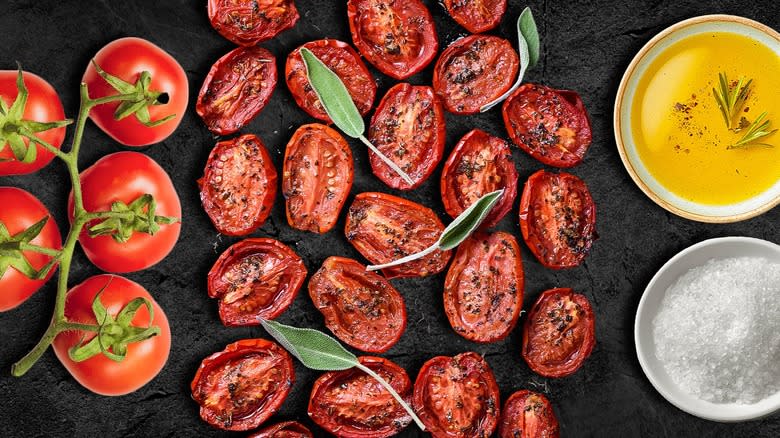
While some cooking methods require time and patience, roasted tomatoes are incredibly easy to make from the comfort of your home. They're delicious to snack on straight from the pan, but they're also a versatile ingredient that appears in everything from roasted balsamic bruschetta to fire-roasted shakshuka. Pizza, pasta, omelets, and more can also benefit from their rich umami flavor and satisfying chew.
Roasted tomatoes are also quite affordable as, in their most minimalist form, all that's required is a drizzle of oil, a pinch of salt, and ideally, fresh tomatoes that fall on the smaller side. But selecting petite produce isn't the only important thing to keep in mind. For example, there are certain steps you need to take to avoid a soggy texture, along with ways to maximize your tomatoes' shelf life before and after roasting. Plus, there are several noteworthy hacks that will save you both effort and tons of time in the kitchen. Without further ado, here are the key tips you need to make perfect roasted tomatoes.
Read more: The 20 Best Olive Oils For Cooking
Opt For Firm, Fresh Tomatoes Rather Than Canned
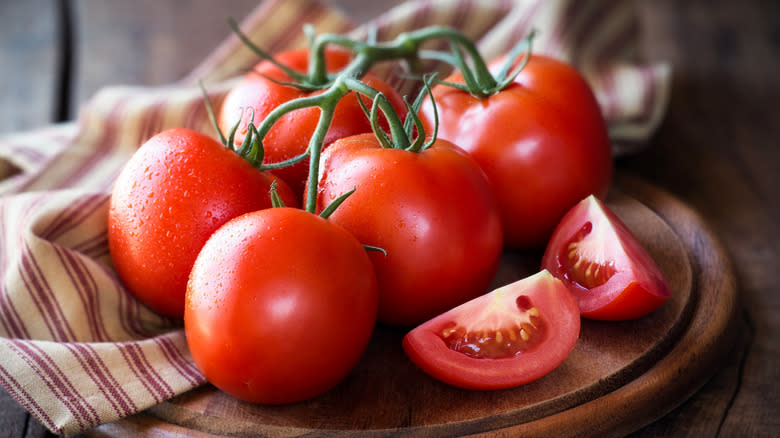
While you can get the most flavor out of canned tomatoes by throwing them in the oven, it's always better to roast fresh tomatoes. This is because canned tomatoes contain excess liquid -- and while their sogginess can improve with heat, the taste and texture will always be subpar to raw produce.
Tomatoes straight from the garden are preferable. But if you don't have that luxury, those found on grocery store shelves are suitable for roasting, too. You should aim to purchase tomatoes when they're in season, which varies across the United States. For example, Florida's tomato season runs from October through June, whereas California's is from April through November.
But regardless of your area's peak harvest period, fresh tomatoes will still yield better results than canned. Select ripe tomatoes that are glossy, bright red without any green spots, and firm to the touch. Note that hard tomatoes should be left on the vine, whereas those that feel similar to a ripe peach are prime for roasting.
Use Smaller, Low-Moisture Tomato Varieties For The Best Results
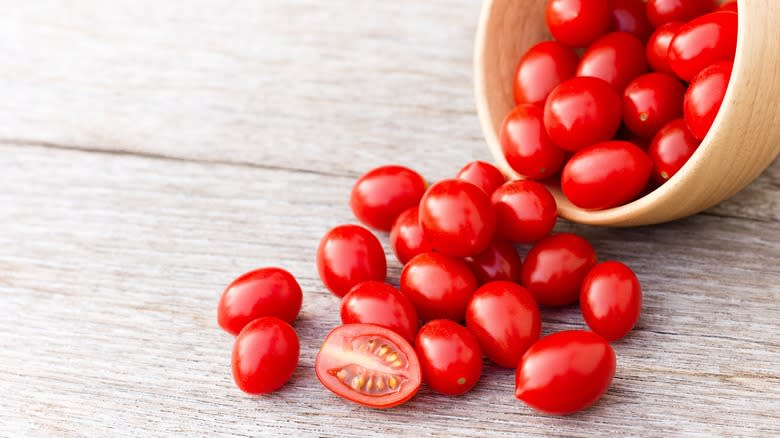
For the same reason you shouldn't use canned tomatoes, you generally want to avoid juicy tomato varieties. While you can use globe or beefsteak cultivars, these slicer tomatoes will significantly increase your cooking time — even if you largely remove their pulp and seeds. For example, a slow-roasted tomatoes with garlic and herbs recipe, while delicious, may occupy your oven for upwards of 6 hours.
Comparatively, chef Thomas Keller's oven-roasted tomato recipe requires just 2 ½ hours of cooking. It calls for plum tomatoes, a category that encompasses Roma, San Marzano, and grape tomatoes, among others. These varieties offer a hearty, umami-rich flavor, low acidity and moisture, and fewer seeds. They also have a tender skin that doesn't require peeling prior to cooking.
Similar characteristics are also evident in cocktail tomatoes, such as Campari hybrids, which are marketed by many grocery stores as tomatoes on the vine. These varieties, as well as cherry tomatoes, are also ideal for roasting.
Store Tomatoes Properly Before Roasting
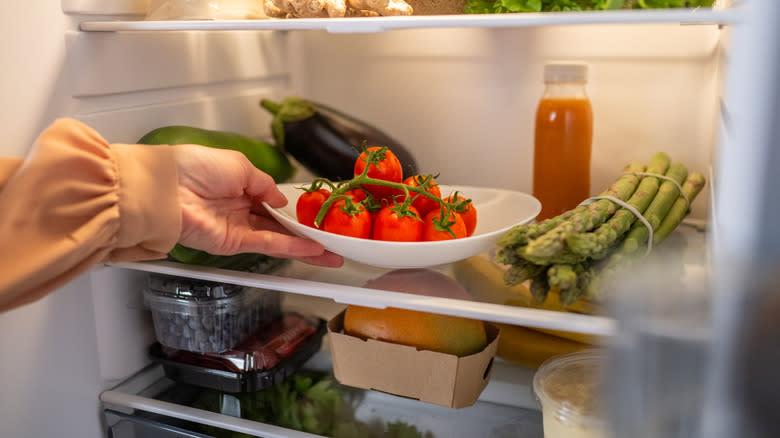
If you follow these steps to a tee, it probably doesn't matter if you refrigerate your tomatoes. Some experts argue that while storing tomatoes in the refrigerator will extend their shelf life, it can also cause a loss of flavor, texture, and aroma. However, any damage can be reversed by simply allowing your ripe tomatoes to return to room temperature prior to cooking.
Concern for what happens if you refrigerate tomatoes really only applies when they're not quite ripe. This is because, like peaches and avocados, tomatoes continue to mature even after they've been picked. Temperatures below 55 F will halt their development. Therefore, hard or partially green tomatoes should be stored on the counter rather than in the fridge.
It's important to note that tomatoes left at room temperature will likely start to degrade within a week's time. Be sure to roast your tomatoes within this period or, if needed, allow them to ripen on the counter. Then, transfer them to the refrigerator to preserve them for up to an additional week.
Slice Or Prick Tomatoes To Prevent Them From Bursting
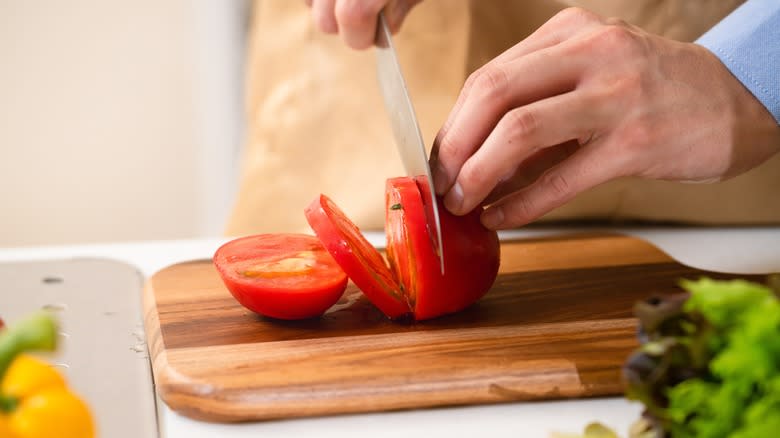
Though they're small, you should think twice before roasting whole cherry tomatoes. While this varietal isn't as juicy as say a large beefsteak tomato, it's still made of about 95% water. If you overlook slicing or pricking your tomatoes before putting them in the oven, steam will build up inside them -- and eventually, they'll burst and make a mess of your appliance. Additionally, the excess liquid may steam your tomatoes, rather than roast them, resulting in a different texture and less concentrated flavor.
Before you start chopping, consider how you plan to use your roasted tomatoes. If they'll add to an omelet, act as a pizza topping, or appear in a salad, you'll likely want to cut out their hard core and slice them into rounds. This method creates a desirable aesthetic, delightful chew, and delicious taste — and can be applied to all types of tomatoes. If preferred, smaller varieties such as grape and cherry tomatoes can quickly be pierced with a fork, allowing steam to escape.
When appearances matter less, like when making this vegan roasted tomato soup recipe, you can simply cut your tomatoes in half or dice larger varieties. However, be sure to aim for some consistency so that the tomatoes cook evenly in the oven.
Line The Sheet Pan Or Air Fryer For Easy Cleanup
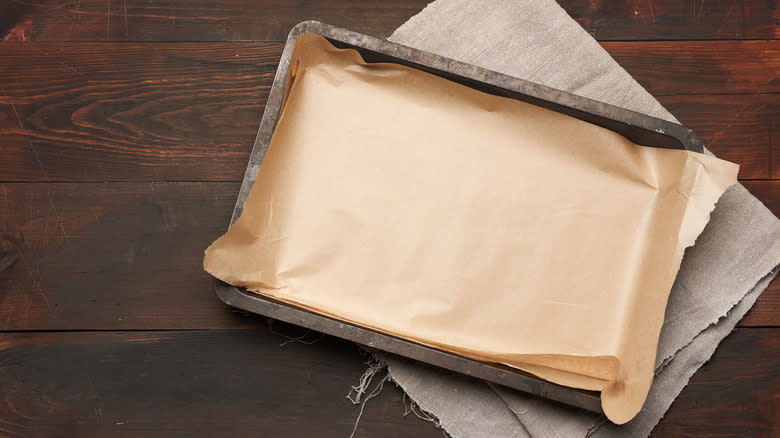
One of the mistakes everyone makes when roasting food is forgetting to line their sheet pan. Even if you use low-moisture tomato varieties, some seepage is unavoidable. While the majority of liquid will evaporate during the cooking process, a bit of browning is bound to occur when roasting tomatoes in the oven or an air fryer. Additionally, without a liner between your tomatoes and a hot metal surface, your precious produce will be likely to stick.
Save yourself some serious dish washing effort by lining your sheet pan with a silicone mat. They're available in many traditional pan sizes and are incredibly easy to clean. Plus, these mats are reusable, and therefore, they're more environmentally friendly than alternative products. However, if you're in a pinch or plan to use your air fryer, know that parchment paper will work just as well in minimizing cleanup.
Note that generally, it's safe to put aluminum foil in an air fryer or oven. However, it should be avoided when roasting tomatoes, as their acidity can break down the foil, thereby leaching small quantities of aluminum into your food. While this amount isn't believed to be harmful to one's health, it will result in an undesirable metallic taste.
Space Tomatoes On A Tray To Keep Them From Becoming Soggy
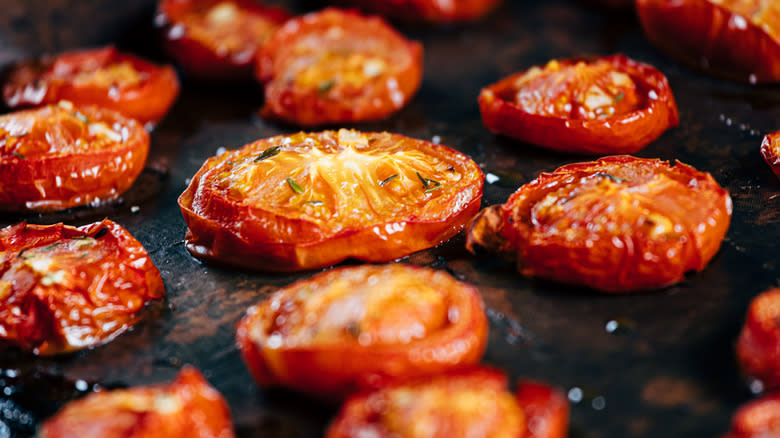
For certain recipes, it's okay to pile tomatoes onto your sheet pan or in your air fryer basket. If you're making soup or roasting tomatoes for homemade tomato sauce, a bit of steaming will still result in a flavorful product. Plus, given that you'll puree these types of dishes, texture isn't of as much importance.
However, consistency greatly matters for most roasted tomato uses. You wouldn't want to snack on soggy tomatoes, nor add them to a sandwich, quiche, or so forth. Fortunately, it's easy to avoid this issue with a bit of foresight. Simply spread your tomatoes into a single layer, leaving roughly a ½ inch between each tomato or tomato piece. This amount of breathing room will allow your tomatoes to properly roast rather than trap moisture.
Similarly, remember to place your tomatoes onto the pan or in the air fryer with the cut sides up. This will better allow the tomatoes' liquid to evaporate, resulting in a thick, chewy bite.
Season Tomatoes With Salt To Draw Out Excess Moisture
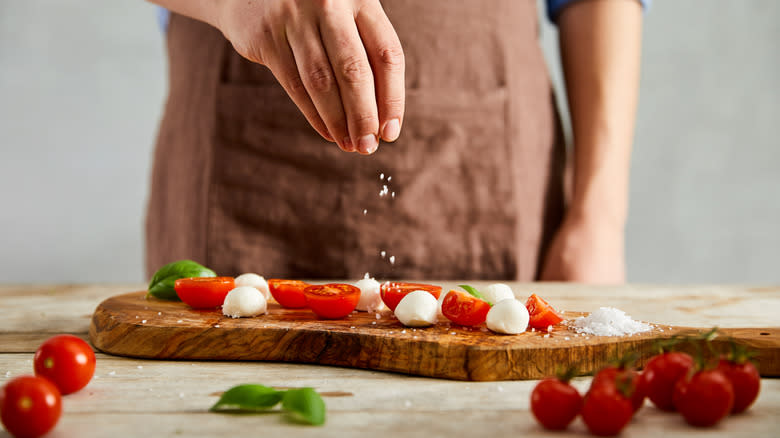
While there are several ways to avoid and eliminate tomatoes' juiciness, there's one key step you shouldn't overlook: you need to salt tomatoes when baking them. This tip especially applies when dehydrating tomatoes in the oven, though even roasted tomatoes can benefit from this flavor-boosting step.
Salt draws even small amounts of moisture to a central location, thereby allowing for a more thorough evaporation process. This also results in a more concentrated product, as there's less water diluting the tomatoes' aromatic and flavor compounds.
To maximize salt's abilities in this regard, lightly season your tomato slices before roasting them. Allow your tomatoes to rest, and after about 10 minutes, absorb any excess moisture with a dry paper towel. Note that you will also pick up some salt, so you may want to add an extra pinch or two prior to popping your tomatoes in the oven or the air fryer.
Coat Tomatoes In Oil, Honey, And Aromatics Before Roasting

You'll find that most often, roasted tomato recipes call for olive oil. It's well known that this classic combination tastes delicious. But according to a study affiliated with Deakin University's School of Nutrition and Public Health, cooking the two ingredients together also boosts the body's ability to absorb lycopene, a compound naturally occurring in tomatoes. Additional research suggests that lycopene may lower the possibility of heart disease and even certain cancers.
Generally, any type of olive oil is suitable for slow roasting. However, note that extra virgin olive oil has a smoke point of between 350 and 410 F, so you may want to opt for pure or light olive oil if your oven is set at a higher temperature.
Prior to roasting, you should also add a drizzle of honey to help the sweetness in your tomatoes shine. Plus, it'll round out any acidity and allow your tomatoes to beautifully caramelize in the oven. You can further season them with complementary aromatics like garlic, oregano, lemon thyme, and black pepper. Fresh or dried herbs can be used, though you may want to opt for the latter if using varieties that are sensitive to heat, such as basil.
Slow Roast Tomatoes In The Oven If Time Permits
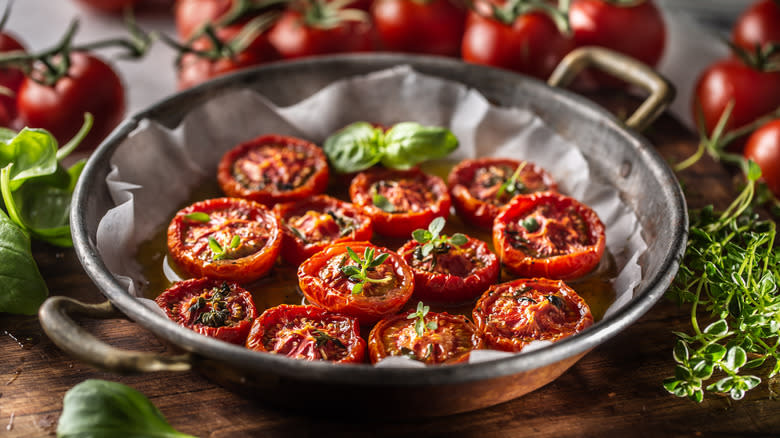
While using smaller tomatoes and removing excess moisture will speed up the cooking process, roasting them in the oven will require a bit of patience regardless. But as the adage goes, good things take time!
The size of your tomatoes will influence their cooking time, but exactly how long they should roast will depend on your personal preference. If you desire a bolder flavor and more chewy texture, similar to sun-dried tomatoes, then slow roast them for 2 to 4 hours at 250 F. If you're more pressed to get the job done, you can set your oven as high as 450 F. At this temperature, your tray of tomatoes can be roasted in as little as half an hour — but keep a close eye, as you run a greater risk of burning them.
Many recipes fall somewhere between these two heat settings. For example, this roast herbed tomatoes recipe from Tasting Table's test kitchen suggests cooking halved plum tomatoes at 375 F for 1 hour and 15 minutes. As its instructions explain, you know your tomatoes are done roasting when they're wrinkled and softened — but not entirely dehydrated. A bit of charring is also recommended.
Pop The Tomatoes On The Grill To Cut Down On Cooking Time
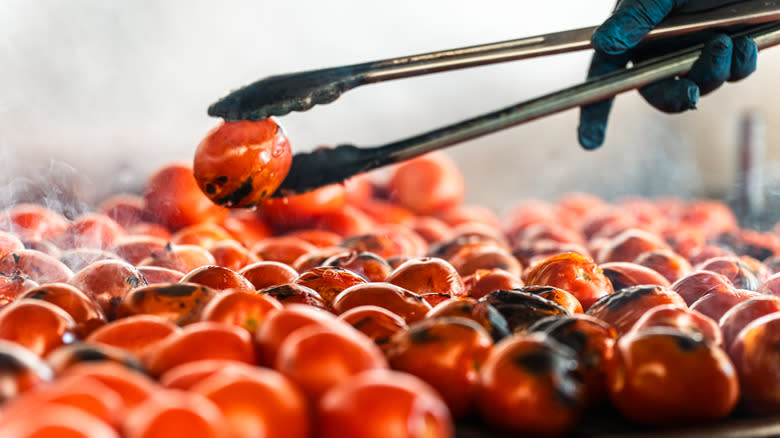
Fancy, flavorful dishes like roasted tomato bucatini don't need to be reserved for the weekend with this genius hack. Speed is one of several reasons why it pays to make roasted tomatoes on the grill instead of in the oven. While the latter cooking method takes at least 30 minutes, a grill set to medium-high heat can produce perfectly roasted tomatoes in as little as 5 minutes -- and it can minimize prep work, too.
Rather than slicing or dicing your tomatoes, simply cut them in half and remove any excess liquid. You can also leave your tomatoes whole, but remember to pierce them with a fork or cut an X-shaped slit into larger varieties so that steam can escape. Then, season your tomatoes and arrange them on a grill pan or directly onto a clean grill grate to create beautiful sear marks. Note that if you do cut your tomatoes in half, you should place the cut side down so that more of the fruit is in contact with the hot surface.
Within five to 10 minutes, you should have tomatoes that are soft and somewhat juicy but charred and smoky in flavor. This method won't produce a chewy texture that may be preferred for certain recipes, but it's a great alternative that works particularly well for soup, pasta, salsa, and so forth.
Roast Tomatoes In An Air Fryer When You're In A Pinch
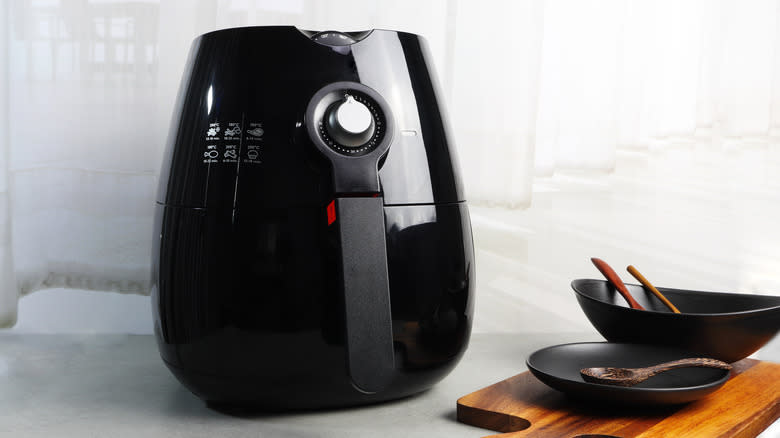
The air fryer is an incredibly popular kitchen appliance thanks, in part, to its versatility and ease of use. Plus, it operates at twice the speed of a standard electric or gas oven, allowing everything from complex dishes to the ordinary tomato to cook promptly. And while the grill method also boasts speed, it's probably not ideal during cold, snowy months of the year.
All of these reasons are your sign to start roasting tomatoes in the air fryer. Doing so requires just a few simple steps. Cover the bottom of your air fryer basket with parchment paper, which -- unlike foil -- will allow hot air to flow and create a convection cooking effect. Additionally, parchment paper will not leach any metallic flavor, and it grants an easier cleanup process.
Once the basket is lined, drop in your seasoned tomatoes, leaving a bit of space between pieces so that they roast and caramelize, rather than steam. Similar to a conventional oven, the temperature at which you'll set your air fryer will vary based on the size of your tomatoes and your preferred texture. Most recipes suggest roasting tomatoes in the air fryer at 370 to 400 F for eight to 20 minutes.
Amplify Flavor With Additional Ingredients
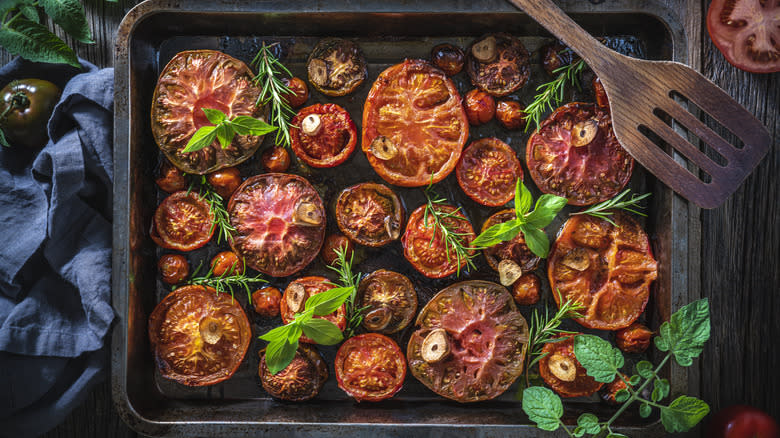
In addition to seasoning your tomatoes prior to roasting, you can intensify and complement their flavor after the cooking process. For example, the use of fresh herbs is one of several tricks to make your tomatoes even more delicious. If you plan to simply snack on your roasted tomatoes, any herbaceous blend will do.
But if you're using your tomatoes in a recipe, consider what other flavors will be present. Cilantro will complement pico de gallo, whereas ribbons of basil will amplify bruschetta — as will a drizzle of balsamic vinegar. An extra glug of quality olive oil can also take roasted tomatoes to the next level, giving them a richer flavor and greater health properties.
A variety of cheeses also pair well with roasted tomatoes. Think a pinch of Parmesan, a sprinkle of feta, or some fresh mozzarella for a classic caprese plate. Along with being the star flavor, roasted tomatoes can also play a supporting role in a variety of dishes, from savory breakfast casseroles to creamy risotto.
Store Roasted Tomatoes In The Fridge Or Freezer
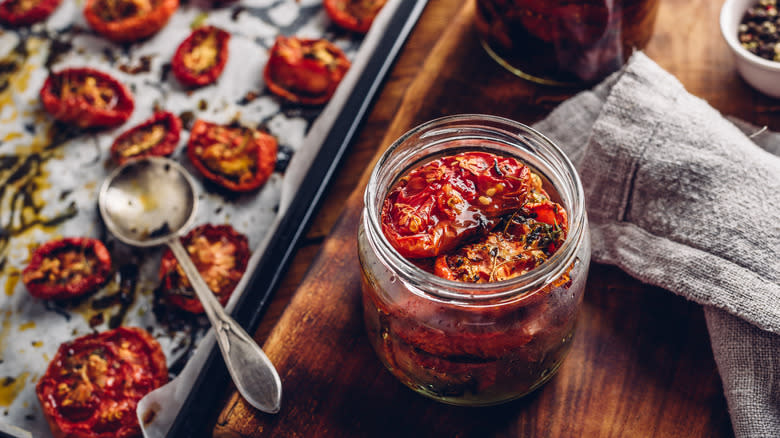
It's important that you store your roasted tomatoes properly in order to maximize their shelf life and maintain a quality flavor. Most commonly, recipes will recommend that you allow your tomatoes to cool, and then store them in an airtight container in the refrigerator. This method will keep your tomatoes fresh for five to seven days.
Alternatively, you can take an approach similar to how you'd pack homemade sun-dried tomatoes in olive oil. Simply place your roasted tomatoes into a jar, cover them completely in olive oil, and twist on a tight lid. Store the jar in the refrigerator and enjoy your tomatoes for one to two weeks.
Whether pulled right off the pan or packed in oil, roasted tomatoes can also be frozen for an even longer shelf life. Ensure that they're stored in freezer-safe bags or containers, label them with your production date, and use them anytime within the next four to six months.
Read the original article on Tasting Table.

